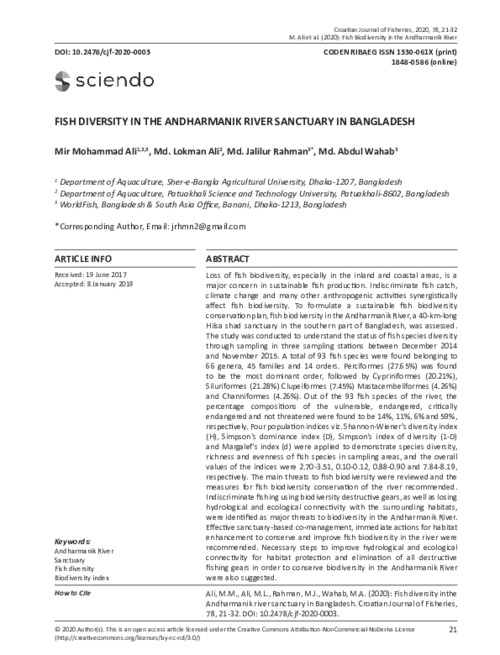Fish Diversity in the Andharmanik River Sanctuary in Bangladesh

Loss of fish biodiversity, especially in the inland and coastal areas, is a major concern in sustainable fish production. Indiscriminate fish catch, climate change and many other anthropogenic activities synergistically affect fish biodiversity. To formulate a sustainable fish biodiversity conservation plan, fish biodiversity in the Andharmanik River, a 40-km-long Hilsa shad sanctuary in the southern part of Bangladesh, was assessed. The study was conducted to understand the status of fish species diversity through sampling in three sampling stations between December 2014 and November 2015. A total of 93 fish species were found belonging to 66 genera, 45 families and 14 orders. Perciformes (27.65%) was found to be the most dominant order, followed by Cypriniformes (20.21%), Siluriformes (21.28%) Clupeiformes (7.45%) Mastacembeliformes (4.26%) and Channiformes (4.26%). Out of the 93 fish species of the river, the percentage compositions of the vulnerable, endangered, critically endangered and not threatened were found to be 14%, 11%, 6% and 59%, respectively. Four population indices viz. Shannon-Wiener’s diversity index (H), Simpson's dominance index (D), Simpson's index of diversity (1-D) and Margalef's index (d) were applied to demonstrate species diversity, richness and evenness of fish species in sampling areas, and the overall values of the indices were 2.70-3.51, 0.10-0.12, 0.88-0.90 and 7.84-8.19, respectively. The main threats to fish biodiversity were reviewed and the measures for fish biodiversity conservation of the river recommended. Indiscriminate fishing using biodiversity destructive gears, as well as losing hydrological and ecological connectivity with the surrounding habitats, were identified as major threats to biodiversity in the Andharmanik River. Effective sanctuary-based co-management, immediate actions for habitat enhancement to conserve and improve fish biodiversity in the river were recommended. Necessary steps to improve hydrological and ecological connectivity for habitat protection and elimination of all destructive fishing gears in order to conserve biodiversity in the Andharmanik River were also suggested.
Permalink
Date Available
Type
Publisher
Countries
ISSN
1330-061X
Copyright
CC-BY-NC-ND-4.0
Research Themes
Language